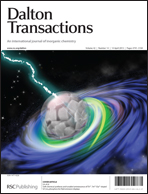The synthesis and characterization of a family of heterometallic Ni4Ln2 complexes (Ln = Pr(1), Sm(2), Eu(3), Gd(4), Tb(5), Ho(6) and Er(7)) of the formula [Ni2LnL1L2(OH)(H2O)]2 are reported, where H4L1 is 3,3′-(1E,1′E)-(2,2′-(2-aminoethylazanediyl)bis(ethane-2,1-diyl)bis(azan-1-yl-1-ylidene))bis(methan-1-yl-1-ylidene)bis(2-hydroxybenzoic acid) and H2L2 is 3-formyl-2-hydroxybenzoic acid. The molecular structures of 1–7 were determined by single-crystal X-ray diffraction and reveal that they are isostructural. In all of these compounds, the six metal ions are held together to form a novel Ni4Ln2O10 core and exhibit a relatively rare dumbbell-type structure. In these compounds, the Ni ions are in slightly distorted square-pyramidal or octahedral environments. An all-oxygen coordination environment (8O) is present around the central lanthanide ion, which is present in a distorted square antiprismatic geometry. The Ln–Ln and Ln–Oavg bond distances in 1–7 show a gradual reduction proceeding from 1 to 7, in accordance with the lanthanide contraction. The luminescent properties of all the compounds have been studied. The magnetic susceptibility analysis demonstrate antiferromagnetic interactions within complex 4.

You have access to this article
 Please wait while we load your content...
Something went wrong. Try again?
Please wait while we load your content...
Something went wrong. Try again?


 Please wait while we load your content...
Please wait while we load your content...